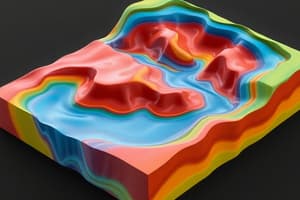Podcast
Questions and Answers
A dynamic reservoir model represents the structure and thickness of the reservoir.
A dynamic reservoir model represents the structure and thickness of the reservoir.
False (B)
Reservoir simulation can help optimize production strategies and estimate reserves accurately.
Reservoir simulation can help optimize production strategies and estimate reserves accurately.
True (A)
The primary goal of reservoir modeling is to decrease hydrocarbon production.
The primary goal of reservoir modeling is to decrease hydrocarbon production.
False (B)
Geo-cellular models are used to quantify reservoir geometry and initial fluid saturation.
Geo-cellular models are used to quantify reservoir geometry and initial fluid saturation.
Static reservoir models do not integrate seismic data in their quantification process.
Static reservoir models do not integrate seismic data in their quantification process.
Fluid resources are located outside of rock formations in subsurface models.
Fluid resources are located outside of rock formations in subsurface models.
Reservoir modeling and simulation rely solely on engineering data.
Reservoir modeling and simulation rely solely on engineering data.
The construction of a reservoir model includes developing a stratigraphic model and determining spatial distributions of various properties.
The construction of a reservoir model includes developing a stratigraphic model and determining spatial distributions of various properties.
Constructing a good reservoir model requires integration of geological, geophysical, petrophysical, and engineering data.
Constructing a good reservoir model requires integration of geological, geophysical, petrophysical, and engineering data.
The SURE Challenge refers to the integration of measurements that have the same scale and environment.
The SURE Challenge refers to the integration of measurements that have the same scale and environment.
Early reservoir models were highly accurate and could account for complex geological features.
Early reservoir models were highly accurate and could account for complex geological features.
2D reservoir models were first introduced in the 1990s.
2D reservoir models were first introduced in the 1990s.
3D reservoir models allow for a more accurate representation of reservoir properties than earlier models.
3D reservoir models allow for a more accurate representation of reservoir properties than earlier models.
The earliest reservoir models primarily focused on production optimization rather than exploration.
The earliest reservoir models primarily focused on production optimization rather than exploration.
Reservoir modeling techniques have evolved over time due to advancements in technology and analysis.
Reservoir modeling techniques have evolved over time due to advancements in technology and analysis.
The integration of geological data in reservoir modeling is a straightforward process without challenges.
The integration of geological data in reservoir modeling is a straightforward process without challenges.
Integrated reservoir models were introduced in the 1990s.
Integrated reservoir models were introduced in the 1990s.
Advanced reservoir models can utilize machine learning techniques.
Advanced reservoir models can utilize machine learning techniques.
Reservoir modeling does not help in predicting future reservoir behavior.
Reservoir modeling does not help in predicting future reservoir behavior.
The main purpose of reservoir modeling is to optimize drilling strategies.
The main purpose of reservoir modeling is to optimize drilling strategies.
Traditional modeling techniques are typically sufficient for unconventional reservoirs.
Traditional modeling techniques are typically sufficient for unconventional reservoirs.
Reservoir modeling can provide insights into water, gas, and oil volumes.
Reservoir modeling can provide insights into water, gas, and oil volumes.
Geological, geophysical, and engineering data are combined in integrated reservoir models.
Geological, geophysical, and engineering data are combined in integrated reservoir models.
Depletion strategies are unrelated to reservoir modeling.
Depletion strategies are unrelated to reservoir modeling.
The exploration stage focuses solely on the economic feasibility of a reservoir.
The exploration stage focuses solely on the economic feasibility of a reservoir.
During the development stage, detailed structural models are mandatory for accurate assessment.
During the development stage, detailed structural models are mandatory for accurate assessment.
Production profiles for oil, gas, and water are computed during the production stage.
Production profiles for oil, gas, and water are computed during the production stage.
Assessing small-scale heterogeneities is a key activity in the production stage.
Assessing small-scale heterogeneities is a key activity in the production stage.
The analysis of fault seals is part of the assessment procedures in the exploration stage.
The analysis of fault seals is part of the assessment procedures in the exploration stage.
Flashcards are hidden until you start studying
Study Notes
Reservoir Modelling Definition
- A digital representation of a subsurface reservoir using geological, geophysical, and engineering data.
- Used to predict fluid flow behaviour within the reservoir.
- Used to optimise production strategies, estimate reserves, and make informed decisions on field development plans.
- The goal is to increase hydrocarbon production with an increased rate of return.
- A 3D geo-cellular model is used to represent the reservoir, including its geometry, lithology, porosity, permeability, and initial fluid saturation.
- Data from seismic data, cores, wireline logs, and outcrops are used to quantify the static reservoir model.
Types of Reservoir Models
- Static reservoir model: Represents the reservoir's structure, thickness, lithology, porosity, and initial fluids.
- Dynamic reservoir model: Represents the changes in fluid flow in the reservoir over time. It is validated with reservoir performance data, such as pressure changes, production and injection rates.
Building a Reservoir Model
- Requires multi-specialty analyses integrating geological, geophysical, petrophysical, and reservoir engineering data.
- Uses scientific and statistical inferences.
- Presents a challenge due to the variety of data types and the many steps involved.
- Represents the SURE Challenge, which refers to the need to integrate measurements that are of different Scale, Uncertainty, Resolution, and Environment.
Evolution of Reservoir Modelling Techniques
- Early reservoir models: Simple and relied on basic geological data. Limited accuracy and didn't consider complex features or heterogeneities. Primarily used for exploration and estimating reservoir size.
- 2D reservoir models: Introduced in the 1980s. Allowed for a more accurate representation of geological features and heterogeneities. Could simulate fluid flow in complex reservoirs, including faults. However, still limited in capturing the full complexity.
- 3D reservoir models: Became popular in the 1990s. Provided a more detailed understanding of the reservoir's structure and properties. Enabled operators to make better decisions about drilling and production.
- Integrated reservoir models: Introduced in the 2000s. Combined geological, geophysical, and engineering data for a more comprehensive overview. Enabled real-time simulation of fluid flow and production, allowing for better prediction of future reservoir behavior.
- Advanced reservoir models: Developed in recent years. Implement machine learning and artificial intelligence for analyzing large datasets and predicting future reservoir behavior.
Uses of Reservoir Modelling
- Evaluation of reservoir volume and the original hydrocarbons in place.
- Representation of geological and petrophysical descriptions of the reservoir for input to reservoir simulation.
- Increase profitability through better reservoir management and optimised development plans for new fields and depletion strategies for mature fields.
- Prediction of fluid volume (oil, gas, and water), decline analysis, secondary or tertiary recovery options, injection strategies, and well and completion designs.
- Observation of fluid movement contacts and pressures.
- Analysis of fault seal and transmissibility, including calculation of the fault's vertical and lateral displacement.
- Assessment of the number and types of wells required for economic production (vertical, slant, horizontal, multilateral, etc.) and their locations.
Reservoir Modelling According to Stage in the Reservoir Life Cycle
Exploration Stage
- Used to delineate reservoir limits and assess economic feasibility.
- Enhances depositional environment and conceptual model understanding.
- Refines stratigraphic model.
- Assesses fault partition.
- Identifies new prospects.
- Acts as a data/information store.
Development Stage
- Builds a more detailed structural and stratigraphic model.
- Plans and designs wells, including the well path.
- Computes production profiles (oil, gas, and water).
- Estimates technical reserves of oil and gas.
- Assesses intermediate-scale reservoir heterogeneities and connectivity.
Production Stage
- Assesses small-scale heterogeneities, including flow units modeling.
- Used for reservoir management.
- Matches past production history (fluid rates, GOR, pressures, etc.).
- Optimises production in the field.
- Performs enhanced oil recovery (EOR).
Studying That Suits You
Use AI to generate personalized quizzes and flashcards to suit your learning preferences.




